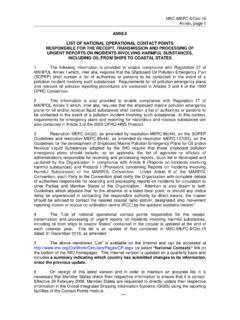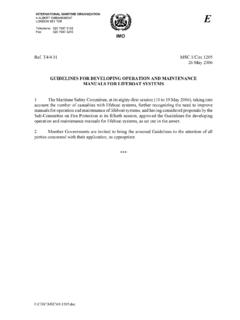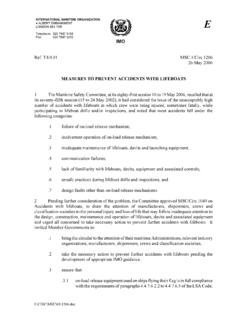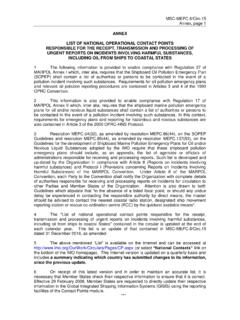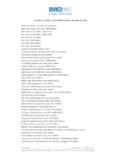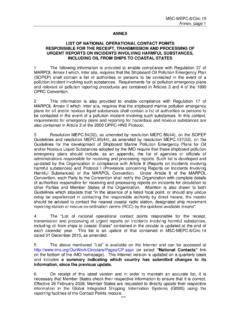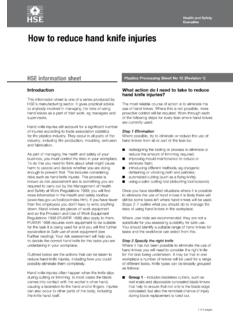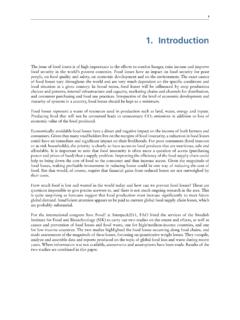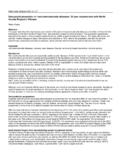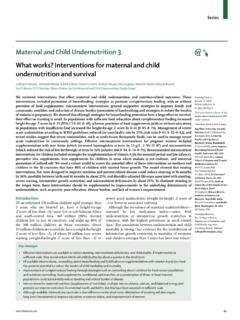Transcription of IMO regulations to reduce air pollution from ships …
1 Frequently Asked Questions IMO regulations to reduce air pollution from ships and the review of fuel oil availability Background: IMO has been working to reduce harmful impacts of shipping on the environment since the 1960s. Annex VI to the International Convention for the Prevention of pollution from ships (MARPOL Convention) was adopted in 1997, to address air pollution from shipping. The regulations for the Prevention of Air pollution from ships (Annex VI) seek to control airborne emissions from ships (SOx, NOx, ODS, VOC shipboard incineration) and their contribution to local and global air pollution , human health issues and environmental problems. Annex VI entered into force on 19 May 2005 and a revised Annex VI with significantly strengthened requirements was adopted in October 2008 which entered into force on 1 July 2010.
2 The regulations to reduce sulphur oxide emissions introduced a global limit for sulphur content of ships fuel oil, with tighter restrictions in designated emission control areas. Why has IMO carried out a review of fuel oil availability? IMO commissioned a review of the availability of low sulphur fuel oil for use by ships , to help Member States determine whether a new lower global cap on sulphur emissions from international shipping shall come into effect on 1 January 2020 or be deferred until 1 January 2025. The current global limit for sulphur content of ships fuel oil is m/m (mass by mass). The new global cap will be m/m will apply on and after 1 January 2020 or 1 January 2025, depending on the outcome of the review.. Who set those dates? The dates were set in 2008 when IMO adopted a revised Annex VI of the International Convention for the Prevention of pollution form ships (MARPOL).
3 Annex VI contains regulations for the prevention of air pollution from ships . Under the revised Annex VI, regulation 14, which covers emissions of sulphur oxides (SOx) and particulate matter from ships , controls sulphur oxide emissions from international shipping by setting progressively stricter limits on the sulphur content of fuel oils used by ships . The regulation also includes a paragraph which states that a review shall be undertaken to inform the decision taken by Parties to the Annex as to whether the lower global cap of no more than m/m shall come into effect on 1 January 2020 or be deferred until 1 January 2025. The regulation says that the review shall be completed by 2018. What will the new global cap mean for ships ? Under the new global cap, ships will have to use fuel oil on board with a sulphur content of no more than m/m, against the current limit of , which has been in effect since 1 January 2012.
4 The interpretation of fuel oil used on board includes use in main and auxiliary engines and boilers. Exemptions are provided for situations involving the safety of the ship or saving life at sea, or if a ship or its equipment is damaged. How can ships meet lower sulphur emission standards? ships can meet the requirement by using low-sulphur compliant fuel oil. An increasing number of ships are also using gas as a fuel as when ignited it leads to negligible sulphur oxide emissions. This has been recognised in the development by IMO of the International Code for ships using Gases and other Low Flashpoint Fuels (the IGF Code), which was adopted in 2015. Another alternative fuel is methanol which is being used on some short sea services. ships may also meet the SOx emission requirements by using approved equivalent methods, such as exhaust gas cleaning systems or scrubbers , which clean the emissions before they are released into the atmosphere.
5 In this case, the equivalent arrangement must be approved by the ship s Administration (the flag State). Who has been carrying out the review? A contractor, CE Delft, was commissioned by IMO to carry out the review following a competitive tender process. Who has overseen the review? A Steering Committee, consisting of 13 Member States, one intergovernmental organisation and six international non-governmental organizations has been overseeing the review. The composition of the Steering Committee (decided by IMO s Marine Environment Protection Committee (MEPC)) is as follows: o IMO Member States Brazil, China, France, Japan, India, Liberia, Marshall Islands, Netherlands, Nigeria, Republic of Korea, Singapore, South Africa, United States o Intergovernmental organization European commission (EC) o Non-governmental organizations BIMCO, Clean Shipping Coalition (CSC), International Bunker Industry Association (IBIA), International Chamber of Shipping (ICS), The Institute of Marine Engineering, Science and Technology (IMarEST), International Petroleum Industry Environmental Conservation Association (IPIECA).
6 What does the review look at? The terms of reference for the review were decided by the MEPC. They include: o Assessment of the predicted demand for compliant fuel oil; and o Assessment of the predicted supply of compliant fuel oil, based on the estimated ability of the refinery industry to supply the projected demand for marine fuel oil meeting the global m/m sulphur limit required, starting in 2020. Who will consider the review? The outcome of the review will be presented to the MEPC, which is open to all IMO Member States. International intergovernmental organizations and international non-governmental organizations in consultative status at IMO can also attend the MEPC as observers and comment on any proposals. The ultimate decision on the date for the cap to take effect will be taken by the Parties to Annex VI.
7 The Parties to MARPOL Annex VI present at MEPC 70 in October will make a decision on the basis of the review. So they could decide on whether the global cap goes ahead in 2020 or is deferred to 2025, taking into account the review. MARPOL Annex VI currently has 87 Parties, who between them represent % of world merchant shipping tonnage (in other words, the majority of ships operating internationally). The current plans are for the 70th session of Marine Environment Protection Committee (MEPC) meeting from 24 to 28 October 2016 to consider the report on the Assessment of the availability of fuel oil as instructed by MEPC. MEPC 69 held last April discussed the timing of the decision and the final report of that meeting reads as follows: Following discussion, the Committee.
8 1 noted the progress made by the Steering Committee and reiterated that, in accordance with the agreed terms of reference, the review is expected to be completed in time for reporting to MEPC 70; and .2 agreed, in principle, that a final decision on the date of implementation of the sulphur limit should be taken at MEPC 70, so that maritime Administrations and industry can prepare and plan accordingly. When was the review submitted to IMO? The Executive Summary of the fuel oil availability study was prepared for submission to the next session of the MEPC (MEPC 70, 24-28 October 2016), by the 13-week document submission deadline (22 July 2016). The final report was submitted by the nine-week deadline at the latest (19 August 2016). This provides ample opportunity for the Member States to consider the report in full.
9 Will the report be available to the public? Initially the report will be available to IMO Member states and IGOs/NGOS. In principle, IMO will make the report available publicly after the MEPC session in October. Does the review look at availability of scrubbers/alternative means? Yes, as part of the demand modelling the review takes into account the predicted uptake of alternative measures to low sulphur fuel oil to meet the requirements, such as scrubbers. Does a decision have to be made at MEPC 70? The MARPOL Annex VI Regulation requires that the review shall be completed by 2018 . This could be interpreted as a decision having to made, at the latest by either MEPC 71 (May 2017) or MEPC 73 (Autumn 2018). However, MEPC 69, taking into account that the review would be completed and submitted to IMO in time for consideration by MEPC 70, agreed in principle to take a decision at MEPC 70.
10 The current plans are for the 70th session of Marine Environment Protection Committee (MEPC) meeting from 24 to 28 October 2016 to consider the report on the Assessment of the availability of fuel oil as instructed by MEPC. When the MEPC decides, does it become binding straightaway? The decision of the Parties to Annex VI to go for 2020 or 2025 is binding straightaway. It is not subject to an acceptance period as the provisions for these dates in the regulations have already entered into force. If a Party of Parties wanted to change to another date, they would need to propose an amendment. If any amendments to the provisions were proposed then they would need to be approved at MEPC 71 at the latest to permit the minimum 22 month period before entering into force before the 1 January 2020.
